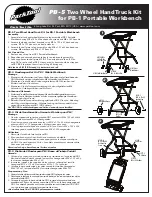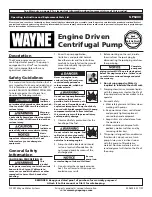
409-32048
Rev A
16
of 64
Explanation
The editor provides up to 20 steps, numbered at the left of the screen, to be entered for a given profile.
The insertion process starts at
row 1, and proceeds from there. Each row has two “events”.
“Height
Above
the Board” and “Force”.
As the press head travels down, the program continuously monitors these events
and acts on whichever occurs first (Height event has priority).
Each event has an “action”, which either
continues the pressing process at another step or generates an error. These events and actions are used
to:
—
detect and announce unexpected contact
—
detect unacceptably high or low force generated during pressing
—
detect a missing connector condition
—
press to/verify the proper seated height
—
repress a connector that has already be partially pressed
There are four basic methods of pressing, and each requires a unique profile.
●
FIXED FORCE PER PIN -
A connector can be pressed with a force proportional to the number of pins,
such as 30 pounds per pin. This is slightly better than simply using an overall fixed force, such as a
hydraulic or pneumatic press provides, because it recognizes that the force applied should be proportional
to the number of pins being pressed. It cannot compensate for normal variations in required force per pin
for different connectors, in different positions, in different boards.
●
PERCENT ABOVE RANGE SAMPLE (PARS)
–
A connector can be pressed with force that is
proportional to the actual resisting force detected during the pressing cycle. This is called Percent Above
Range Sample or PARS.
In this technique, the connector’s resisting force w
hile pressing is sampled and
averaged over a distance Range before seating to the board surface. The final force exerted on the
connector is limited to a user-programmed Percent Above the Sample force. This percent added assures
complete seating of the connector. This is the most widely used technique because it limits the stress to
the assembly and does not require accurate board thickness measurement.
●
PRESS TO HEIGHT
–
A connector can be pressed to within a programmed distance short of seating on
the board surface. This is the gentlest process possible because it exerts only enough force to press the
pins into the board. No excess force is pressed into the connector plastic or the board. This sophisticated
technique is made possible by the control available using an electric servo press head and a rigid press
structure. In order for press to height to be accurate, the board thickness must be precisely known. This
can be done using the thickness measurement probe and sequence provided.
●
FORCE GRADIENT -
Monitors the rate of change of force to distance. This method is used for robust
connectors that need to be seated against the board surface. Generally, the force vs distance plot will
make a steep upturn as the connector contacts the board surface. The connector stops moving so the
force rises quickly. A minimum angle is specified for the upturn which corresponds to how solidly the
connector is pressed against the board. See “Press Profile” for more detail.
The “standard” profile for each of the techniques
above is provided with the press. They use variables
whose values come from the Connector and Tool databases rather than discrete numbers. Since each
connector requires the same basic steps, one profile with variables can be used for many different
connectors.
Entries
“Height”
-
This defines the next destination of the pressing surface of the tool in inches above the board.
The press head will drive to this height at a speed that is linearly “ramped” from the height and speed of
the previous step.
The initi
al height (before step 1) is defined in the “Board Clearance” section of the “Press Data File”.
The
available variables are shown in Figure 14. Alternatively, a numeric height can be entered.
















































